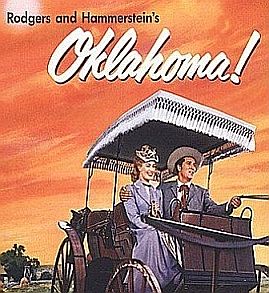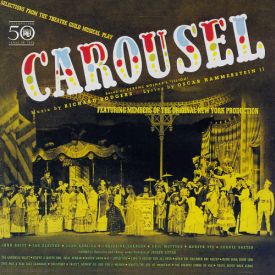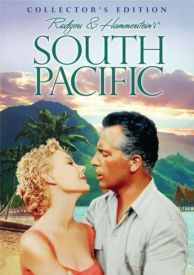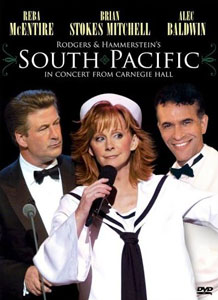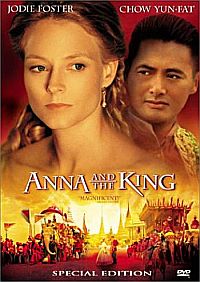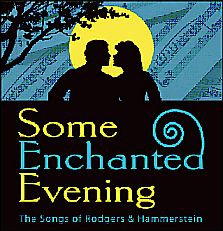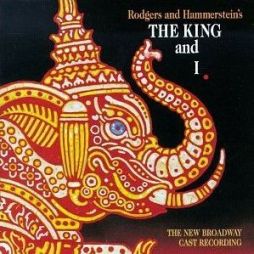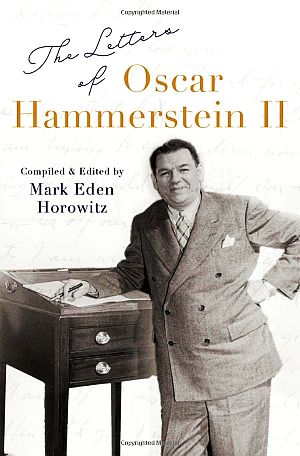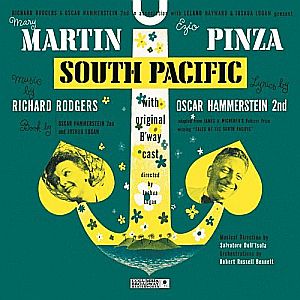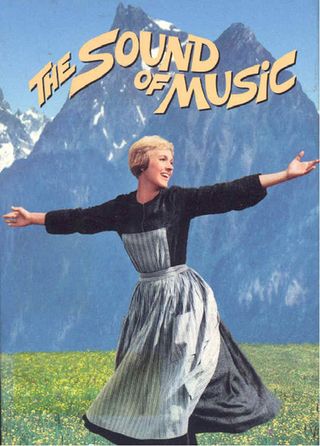
A poster for the 1965 film version of Rodgers & Hammerstein’s ‘The Sound of Music,’ one of many R&H productions that have yielded long-lived economic returns in music, film, and continuing stage productions. Click for 50th anniversary DVD edition.
Richard Rodgers (1902-1979) and Oscar Hammerstein (1895-1960) were the re- nowned American songwriting team who created a string of popular Broadway musicals in the 1940s and 1950s.
“Rodgers & Hammerstein,” as they are popularly known, reigned over what is considered the golden age of Broadway. Richard Rodgers did the composing and Oscar Hammerstein the writing.
The musicals with their songs — and the film versions that typically followed — garnered an impressive array of awards over the years, among them some 34 Tony awards, 15 Academy Awards, two Pulitzer Prizes, and two Grammys. Five of their shows — Oklahoma!, Carousel, South Pacific, The King and I, and The Sound of Music — became runaway successes and are now regarded as musical icons. The music from these shows — and other Rodgers & Hammerstein work — remains popular among millions around the world and is regarded as a business gold mine.
In the deal that Imagem made, it acquired not only Rodgers & Hammerstein rights, but others as well, covering some 12,000 songs, 900 concert works, 100 musicals, and 200 writers. Among these are compositions by Irving Berlin and Mr. Rodgers’s other collaborator, Lorenz Hart. Irving Berlin’s song “White Christmas” — one of history’s top-selling songs ever — and his hit musical, Annie Get Your Gun, are also included, as are the Rodgers & Hart songs “Pal Joey” and “The Lady is a Tramp.” Imagem made its deal with the New York city-based Rodgers & Hammerstein Organization (RHO), which formerly managed all of this material. Imagem essentially acquired the RHO organization wholesale, retaining its existing management staff.
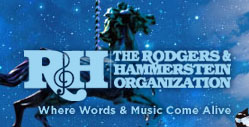
The Rodgers & Hammerstein Organization was created in 1943 to manage the works of Richard Rodgers & Oscar Hammerstein.
“The sale represents a transfer of power over one of America’s most famous song catalogs and the licensing rights for future productions of the musicals,” wrote New York Times reporter Patrick Healy. RHO president and executive director, Theodore S. Chapin, who agreed to stay on at RHO, suggested that Imagem’s global reach would help RHO find new licensing deals for their holdings in Europe and Asia. “[S]ince Imagem is global,” he said, “I hope they can help us disseminate the works we represent with a little more moxie.”
Over the years, RHO had run its business fairly conservatively, collecting royalties from tens of thousands of licenses it issued for theatrical productions of R&H works. They also issued thousands of licenses for performances and recordings of their copyrighted songs, musicals, and concert works. Imagem’s deal with RHO covers some 12,000 songs, 900 concert works, 100 musicals and 200 writers. By 1990, for example, RHO was licensing about 3,000 productions a year and its music-publishing division employed about 20 people. RHO had been run in recent years by two Rodgers & Hammerstein heirs — daughters Mary Rodgers Guettel and Alice Hammerstein Mathias, who appeared satisfied with the deal they made with Imagem. Speaking on behalf of the Hammerstein family, Alice Hammerstein Mathias stated: “The collaboration between my father and Richard Rodgers was extraordinary. That they kept everything together, including the management of their copyrights, is a testament to their shared vision, and now that vision will be continued in this promising new venture.” Added Mary Rodgers Guettel: “My father always believed in moving forward. This is a big and wonderful step, and I am thrilled by the new opportunities that André and his team bring to my father’s songs and shows…”
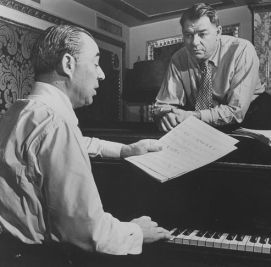
The composer Richard Rodgers, left, and the lyricist Oscar Hammerstein at work in 1953.
Rodgers & Hammerstein
RHO was initially founded by Richard Rodgers and Oscar Hammerstein in 1943, then for the purpose of controlling their own musicals, and additionally, those of Rodgers and Lorenz Hart, some separate Hammerstein works, and later other properties such as Irving Berlin’s Annie Get Your Gun of 1946.
In the early 1940s, by the time Rodgers and Hammerstein came together for their extended collaboration, they had each had separate careers. They were both over 40 by then.
Hammerstein had success in the 1920s, helping create stage hits with operetta-style musicals such as Rose-Marie of 1924 and The Desert Song of 1926.
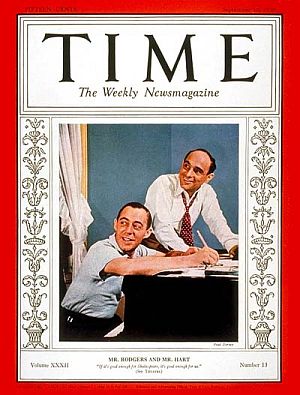 Richard Rodgers and Lorenz Hart on the cover of Time magazine, September 26, 1938. |
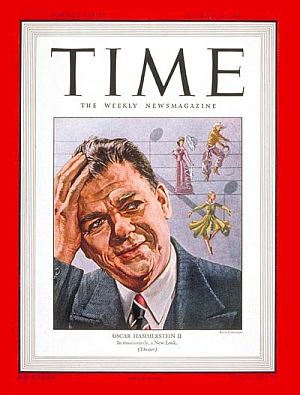 Oscar Hammerstein II on the cover of Time magazine, October 20, 1947. |
In 1927, his hit musical Show Boat(with Jerome Kern), broke new ground on Broadway on a number of fronts, becoming the first, as they say, to integrate “book, music and lyrics” into a coherent whole.
Show Boat, known for Paul Robeson’s classic performance of “Old Man River,’ also broached several social issues, among them, addictive gambling, alcoholism, racism and interracial marriage.
Hammerstein, in fact, would become known as a key innovator and “book writer” on Broadway — making the story, not the songs or the performers, central to the production. Still, by the early 1940s, Hammerstein’s good fortune had evaporated and he went for about ten years without a hit show.
Richard Rodgers on the other hand, working with lyricist Lorenz Hart, had composed the scores for a number of hit shows that included: On Your Toes (1936), Babes in Arms (1937), The Boys From Syracuse (1938), Pal Joey (1940), and By Jupiter (1942). More than 80 popular tunes came from those works.
Both Rodgers and Hart were featured on the cover of Time magazine in September 1938. But Hart’s health was in decline and he passed away in 1943.
Rodgers and Hammerstein, who had worked together on occasion in the past, came together again in the early 1940s to work on what would became Oklahoma! This production furthered what Hammerstein had started in Show Boat — focusing on story, and integrating all aspects of the musical around plot and characters. Oklahoma! began the string of major Rodgers & Hammerstein successes, five of which are explored in more detail below.
Between them, Rodgers and Hammerstein had a prolific output over the years. Hammerstein wrote an estimated 850 songs; Rodgers composed more than 900. Their work, either separately or together, is found in more than 40 Broadway musicals, and indirectly in many others, as well as Hollywood films and television adaptations.
Hammerstein died at the age of 65 shortly after the opening of The Sound of Music in 1960. Rodgers died in 1979 at age 77.
Musical Value
The Rodgers & Hammerstein acquisition by Imagem offers a continuing source of economic value for its new owners. Fees from music publishing rights can be collected from a broad range of uses, and many of these are not vulnerable to piracy. While the major record labels have suffered in recent years with declining sales due to changing technology, music publishing rights are still quite lucrative. This part of the music business has held its value far better than recordings.Music publishers make money when songs are played on the radio, in restaurants and bars, and when any version of a song is used in a movie, TV show, video game, or commercial advertisement. Also, other artists singing Rodgers & Hammerstein tunes — called “cover versions” — require license arrangements and yield standard royalties. The Rodgers & Hammerstein properties already have an extensive track record of doing business of one kind or another, and more is expected.
“My Favorite Things” from The Sound of Music, for example — made popular during its Broadway run and with Julie Andrews in the film version — has been used in advertising. In the late 1980s and early 1990s, the song was used in automobile commercials for Mitsubishi. In 2007, it was used in advertisements for the Skoda Fabia, a mini-car produced by Czech auto maker Škoda, owned by Volkswagen. It was also used that year in Master Card ads, one of which featured actress and singer Penelope Fortier.“My Favorite Things” has also become a jazz standard, with John Coltrane’s album of the same name becoming a historic landmark of sorts, which helped spark the rediscovery of soprano sax. The song has also been performed by a range of artists in jazz and other styles, including: Stanley Jordan, Grant Green, Carmen Lundy, Dave Brubeck, Bill Evans, McCoy Tyner, Kenny Rogers, Tanya Tucker, Rod Stewart, Sarah Vaughan, The Supremes, the Gimme Gimmes, Kimiko Itoh, Tony Bennett, 2Pac, Barbra Streisand, Tennessee Ernie Ford, Andy Williams, Luther Vandross, and others.
“Climb Ev’ry Mountain,” another Sound of Music song, was used by Australian Idol contestant Guy Sebastian in 2003 when he performed it on Australian TV in the show’s first season there. Sebastian went on to win, becoming the first Australian Idol, and in 2004 he recorded “Climb Ev’ry Mountain” on his No.1 single, “All I Need Is You.” The Rodgers & Hammerstein song was also adapted for National Australia Bank’s “Confidence” TV ad campaign in 2007.
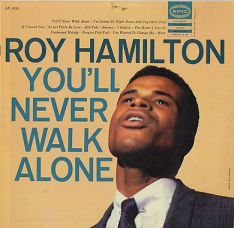
In 1954, Roy Hamilton’s version of ‘You'll Never Walk Alone’, became an R&B No.1 hit for eight weeks and a national Top 30 hit, boosting Hamilton to fame. Click for digital.
|
“You’ll Never Walk Alone” When you walk through the storm Walk on, through the wind Walk on, walk on, with hope in your heart |
Rodgers & Hammerstein’s “Some Enchanted Evening” from South Pacific was recorded by a succession of popular artists in the first year of its release, 1949, including: Frank Sinatra, Perry Como, Jo Stafford, Bing Crosby, Ezio Pinza (original cast recording), and Al Jolson. But in later years as well, others also did versions of the song, including Willie Nelson, Jay and the Americans, and Barbra Streisand. Jon Bon Jovi did it on the Ally McBeal TV show, and even Harrison Ford did a version in the film American Graffiti.
“People Will Say We’re in Love” from Oklahoma! has also been covered by dozens of artists, some resulting in early Top 40 hits — Bing Crosby ( No.2), Frank Sinatra ( No. 3) and The Ink Spots ( No. 11).
“Hello, Young Lovers” from 1951’s The King and I was covered that year by Perry Como and Guy Lombardo with Kenny Martin. Earl Grant did the song on his 1958 album The End. Bobby Darin did an upbeat swinging version of the song, and Paul Anka had a popular 1960 version in the Bobby Darin style.
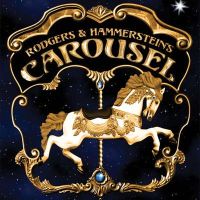
Poster art for a production of Rodgers & Hammerstein’s ‘Carousel'.
RHO, despite this history of success, has not been the most aggressive marketer of its portfolio’s possibilities. Primarily, it has been content to steadily licence its shows for stage productions, while limiting the exposure of its classic works in an attempt to protect their value.
It is known, however, that there is increasing demand for use of R&H material in film and television. But in the past, RHO has usually denied these kinds of uses because they sought to uphold the artistic integrity of their work, only licensing it for theatrical production and concerts. Imagem, on the other hand, is expected to seek a fuller range of marketing options.
|
Imagem’s Playlist “Love & Affection” |
Imagem’s Portfolio
Imagem, however, is something of a newcomer to the global music and entertainment industry. It was founded in 2008 by ABP, one of the world’s biggest pension funds ($223 billion), in conjunction with Dutch independent music publisher and media company CP Masters. ABP is the pension fund for some 2.6 million persons and employers who work for the Dutch government or its education system.
Imagem began building its business by acquiring other music publishing rights and music catalogs. After Universal Music Group bought Bertelsmann’s BMG music-publishing unit, several of its pop music catalogs were spun off to satisfy federal anti-trust regulators — Zomba UK, Rondor UK, 19 Music, and 19 Songs. Imagem then picked up these catalogs.
As of mid-2009, Imagem’s collection included a number of tunes from pop artists such as those in the box at right, including: Madonna, Linkin Park, Celine Dion, Justin Timberlake and others. From its London location, Imagem manages its back catalog and has a roster of 40 writers creating new music. It also seeks out and signs new talent, recently signing, for example, artists such as Australia’s Jarrad Rogers and the Portico Quartet.
In April 2008, Imagem acquired Boosey & Hawkes, a large classical-music publisher, whose catalog includes works of renowned artists such as, Benjamin Britten, Aaron Copland, Serge Prokofieff, Igor Stravinsky, and Sergei Rachmaninoff. This catalog also includes jazz and other works by artists and composers such as Karl Jenkins, Elliott Carter, John Adams, and Wynton Marsalis. Boosey and Hawkes is also involved in the market for music in advertising and film, where revenues are currently growing at about 30 percent annually per annum, according to Imagem. Other clients at Boosey & Hawkes include orchestras, choirs, record companies, and radio stations.
In the April 2009 deal with RHO, Imagem also acquired works by other artists including Adam Guettel, Sheldon Harnick, Jerome Kern, Stephen Schwartz, Kurt Weill, Lin-Manuel Miranda, and others. RHO had represented Andrew Lloyd Webber in the past, including his musicals Cats, Evita, and Joseph and the Amazing Technicolor Dreamcoat. At the time of the deal with Imagem, RHO and Webber’s group were in discussions about continuing that relationship.
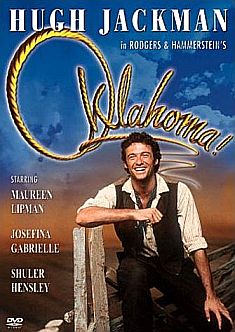
Actor Hugh Jackman on cover of a 1999 production of Rodgers & Hammerstein’s ‘Oklahoma!’. Click for Blu-ray or DVD.
Imagem appears eager and willing to go where other established music business interests will not go, and willing also to spend what others will not. In the recently completed Rodgers & Hammerstein deal, other potential suitors included some of the world’s biggest music publishers, among them, Warner Music Group’s Warner/Chappell Music and Sony Corp.’s Sony/ATV Music Publishing. These two had considered buying RHO, but dropped out of the bidding because they considered it overpriced, especially for a catalog of Broadway songs.
“Our purchase of the Rodgers & Hammerstein Organization is a once in a lifetime opportunity to acquire the publishing and theatrical rights of some of the most beloved shows and songs ever written,” said CEO André de Raaff at the time of the deal. He also added: “I personally believe that the world of musicals in which RHO is a leading player will grow further on a worldwide basis and we look forward to adding value to these rights through long term cultivation and development.”
Update. Since this story was first posted in 2009, Imagem and its properties have been absorbed by a larger company. On June 2, 2017, Concord, an independent creative rights company headquartered in Nashville that develops, manages and acquires music and theatrical rights, acquired Imagem for $500 million. The deal included 250,000 Imagem compositions and tripled Concord’s publishing copyrights and holdings. Imagem’s pop catalog by then also included works by Nik Kershaw, Phil Collins, Genesis, The Temper Trap, M.I.A., Pink Floyd, Vampire Weekend, Dire Straits and Daft Punk; as well as some European rights to Linkin Park and Justin Timberlake. Concord holds rights to nearly 900,000 songs, composed works, plays, musicals and active recordings – “The Sound of Money,” indeed ! For more on Concord, see Wikipedia.
For additional stories at this website on “Film & Hollywood” topics, see that category page, and for stories on music-related topics, see the “Annals of Music” page. Thanks for visiting – and if you like what you find here, please make a donation to help support this website. Thank you. – Jack Doyle
|
Please Support Thank You |
_____________________________
Date Posted: 24 June 2009
Last Update: 18 September 2022
Comments to: jackdoyle47@gmail.com
Twitter: https://twitter.com/PopHistoryDig
Article Citation:
Jack Doyle, “The Sound of Money, 2009,”
PopHistoryDig.com, June 24, 2009.
_____________________________
Sources, Links & Additional Information
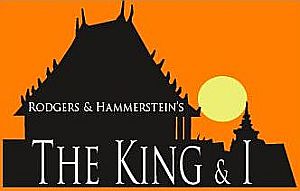 Poster art for a production of Rodgers & Hammerstein’s ‘The King & I’. |
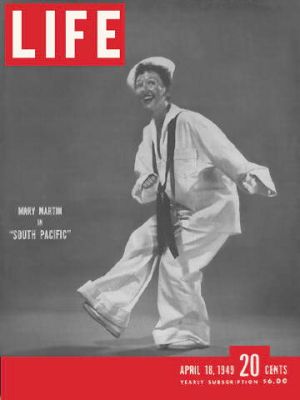 Mary Martin, co-star of Rodgers & Hammerstein’s ‘South Pacific,’ shown on the cover of Life magazine, April 18, 1949, as the show began playing on Broadway. |
Brian Garrity, “Sale Overtures: Rodgers & Hammerstein Ouevre May Be on Block “ New York Post, September 2, 2008.
Ethan Smith, “New Partners for a Music Catalog; Dutch Investors Buy Rights to Rodgers & Hammerstein, Adding to Library,” Wall Street Journal, April 21, 2009, p. B-6.
United Press International, “Rodgers & Hammerstein Catalog Sold,” UPI.com, April 21, 2009.
Andre Paine, London, “Imagem Acquires Rodgers & Hammerstein Org,” Billboard. Biz, April 21, 2009.
The Rodgers & Hammerstein Organization, New York, NY.
Joe Dziemianowicz and Leo Standora, “Songs Sale ‘Something Wonderful’,” New York Daily News, Tuesday, April 21, 2009.
Gordon Cox, “Imagem Nabs Rodgers & Hammerstein,” Variety.com, Tuesday, April 21, 2009.
Patrick Healy, “Rodgers and Hammerstein Catalog Sold,” New York Times, April 22, 2009, p. C-3.
Press Release, “Imagem Music Group Buys R&H — Imagem Music Group Buys Rodgers & Hammerstein, Becoming World’s Leading Independent Music Publisher,” The Rodgers and Hammerstein Organization, Updated, May 22, 2009.
Andrew Lloyd Webber, “The Showmen,” Time, Monday, June 8, 1998.
“Rodgers and Hammerstein,” Wikipedia .org.
Laurence Maslon, “Memorable Musicals: Oklahoma!,” Broadway: The American Musical, A Production of Thirteen/WNET New York., PBS, The Public Broadcasting System, 2004.
Erik Piepenburg, Arts Beat Blog, “Some Enchanted Musical,” New York Times, April 6, 2009.
David W. Dunlap, Commercial Property, “Tin Pan Alley; Rodgers & Hammerstein Is Moving to Broadway,” New York Times, January 14, 1990.
“South Pacific (musical),” Wikipedia.org.
“South Pacific,” TheatreHistory.com.
“The King And I,” TheatreHistory.com.
Stephen Holden, Theater, “Their Songs Were America’s Happy Talk,” New York Times, Sunday, January 24, 1993.
Bert Fink, “From Broadway to Hollywood,” Show History, The Sound of Music, The Rodgers and Hammerstein Organization, New York, NY.
“The Gross Is Greener” (re: The Sound of Music), Time, Friday, January 14, 1966.
Todd S. Purdum, “The Hills Still Resonate,” New York Times, May 30, 2005.
Richard Corliss, “That Old Feeling: Richard Rodgers’ Century,” Time, Friday, June 28, 2002.
“Richard Rodgers,” Wikipedia.org.
Geoffrey Block, The Richard Rodgers Reader, New York: Oxford University Press, 2002.
Frederick Nolan, The Sound of Their Music: The Story of Rodgers and Hammerstein, New York: Applause Books, 2002.
Richard Harrington, “Some Enchanted Teaming; Discs Celebrate Rodgers & Hammerstein’s 50th,” Washington Post, September 8, 1993, p. D-7.
